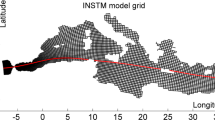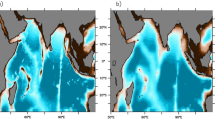Abstract
We develop a simple dynamical system model of the Arctic Ocean and marginal seas by applying the Martinson, Killworth and Gordon box model of a high-latitude two-layer ocean to four regions connected together: the Greenland Sea, the Norwegian Sea, the Arctic Ocean, and the Greenland Gyre. The latter is a small convective region embedded in the northwest corner of the Norwegian Sea. The model for each region consists of a thermodynamic ice layer that covers two layers of saline water which can, under specific conditions, become statically unstable and hence create a state of active overturning. The system is forced by monthly mean atmospheric temperatures in the four regions, by continental runoffs and by inflows from adjacent oceans. The model predicts the ice thickness, and the temperature and salinity of the water in the upper layer of the four regions. Also determined are the water temperature and salinity of the lower layer in the Arctic Ocean box. The convective state of any given region, i.e. whether it is in an active overturning mode or not, is also determined as a continuous function of time. The different output variables of the model, which are the response to climatological forcing conditions, compare favourably with observed data. In the control run, the Arctic Ocean region is characterized by continuous ice cover, the Greenland Sea and Greenland Gyre have ice cover only during winter, and the Norwegian Sea region never forms an ice cover. Another feature of the control run is the winter time occurrence of convective overturning in the upper 200 m in the Greenland Gyre region. The model is also used for different anomaly experiments: a positive air temperature anomaly which represents a global warming of the earth, a negative salt anomaly in the Norwegian Sea which simulates the great salinity anomaly of the 1960s and 1970s, and an increase in the ice flux through Fram Strait which parameterizes anomalous ice production in the Arctic.
Similar content being viewed by others
References
Aagaard K, Carmark EC (1989) The role of sea ice and other fresh water in the Arctic circulation. J Geophys Res 94:14485–14498
Björk G (1989) A one-dimensional time-dependent model for the vertical stratification of the upper Arctic Ocean. J Phys Oceanogr 19:52–67
Bourke RH, Garrett RP (1987) Sea ice thickness distribution in the Arctic Ocean. Cold Regions Sci Techn 13:259–280
Bourke RH, McLaren AS (1992) Contour mapping of Arctic basin ice draft and roughness parameters. J Geophys Res 97:17715–17728
Carmack E, Aagaard K (1973) On the deep water of the Greenland Sea. Deep-Sea Res 20:687–715
Carmack EC (1990) Large-scale physical oceanography of polar oceans. In: Polar oceanography, Part A: physical science. Academic Press, San Diego, pp 171–222
Clarke RA, Swift JH, Reid JL, Koltermann KP (1990) The formation of Greenland Sea deep water: double diffusion or deep convection? Deep-Sea Res 37:1385–1424
Coachman LK, Aagaard K (1974) Physical oceanography of arctic and subarctic seas. In: Marine geology and oceanography of the Arctic Seas. Springer, New York Heidelberg Berlin, pp 1–72
Darby MS, Willmott AJ (1993) A simple time-dependent coupled ice-ocean model with application to the Greenland-Norwegian Sea. Tellus 45:221–246
Dickson RR, Meincke J, Malmberg SA, Lee AJ (1988) The “great salinity anomaly” in the northern North Atlantic 1968–1982. Prog Oceanogr 20:103–151
Holland DM, Mysak LA, Oberhuber JM (1991) Simulation of the seasonal Arctic sea-ice cover with a dynamic thermodynamic sea-ice model. Center for Climate and Global Change Res Rep No. 91–17, McGill University, Montreal
Martinson DG, Killworth PD, Gordon AL (1981) A convective model for the Weddell polynya. J Phys Oceanogr 11:466–488
Midttun L (1985) Formation of dense bottom water in the Barents Sea. Deep-Sea Res 32:1233–1241
Mysak LA, Manak DK (1989) Arctic sea-ice extent and anomalies, 1953–1984. Atmosphere-Ocean 27:376–405
Mysak LA, Power SB (1992) Sea-ice anomalies in the western Arctic and Greenland-Iceland Sea and their relation to an interdecadal climate cycle. Climatol Bull 26:147–176
Mysak LA, Wang J (1991) Climatic atlas of seasonal and annual Arctic sea-level pressures, SLP anomalies and sea-ice concentrations, 1953–88. Center for Climate and Global Change Res Rep No. 91–14, McGill University, Montreal
Mysak LA, Manak DK, Marsden RF (1990) Sea-ice anomalies observed in the Greenland and Labrador Seas during 1901–1984 and their relation to an interdecadal Arctic climate cycle. Clim Dyn 5:111–133
Røed LP (1984) A thermodynamic coupled ice-ocean model of the marginal ice zone. J Phys Oceanogr 14:1921–1929
Serreze MC, Maslanik JA, Barry RG, Demaria TL (1992) Winter atmospheric circulation in the Arctic basin and possible relationships to the great salinity anomaly in the northern Atlantic. Geophys Res Let 19–3:293–296
Shea DJ (1986) Climatological atlas: 1950–1979. Surface air temperature, precipitation, sea-level pressure and sea-surface temperature (45°S-90°N). NCAR Tech Note-269+STR, Boulder, Colo. USA
Turner JS (1973) Buoyancy effects in fluids. Cambridge University Press, London, 367 pp
Unesco (1983) Algorithms for computation of fundamental properties of seawater. Unesco Techn Pap Mar Sci, 44, Paris
Welander P, Bauer J (1977) On a differentially heated saltwaterice system. Tellus 29:462–469
Wood RG, Mysak LA (1989) A simple ice-ocean model for the Greenland Sea. J Phys Oceanogr 19:1865–1880
Author information
Authors and Affiliations
Rights and permissions
About this article
Cite this article
Robitaille, D.Y., Mysak, L.A. & Darby, M.S. A box model study of the Greenland Sea, Norwegian Sea, and Arctic Ocean. Climate Dynamics 11, 51–70 (1995). https://doi.org/10.1007/BF00220676
Issue Date:
DOI: https://doi.org/10.1007/BF00220676




